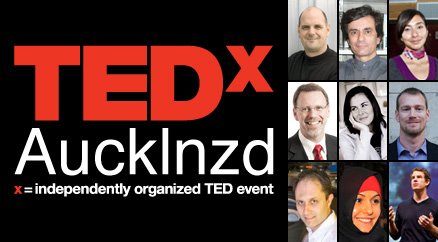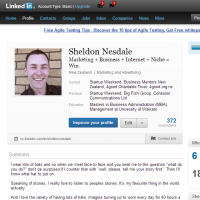TEDx Auckland ran from 10am to 5.30pm on 6 Oct 2012: 7.5 hours of awesomeness.

But my day started at 6am because I drove up from Tauranga for it, and got back home at 10pm.
I’m still counting the 8.5 hours of waiting and driving because those were all awesome too. I was either talking to my car buddy Rachel Tabb from Bubble Interiors about our businesses, family, lives, dreams and aspirations. Or, chatting to new people we met during the day and catching up with friends.
I’ve been watching TED videos for a few years now (3-5 a week), but to have the speakers right in front of you, really engages your other senses and drives the content and their message into you.
We turned up at the event an hour early, which was good because I had left my tickets at home.
Oops.
I explained this to one of the key organisers: Elliot Blade and he gave me a ViP ticket.
Yay!
This turned out to be awesome because I grabbed a seat in the centre on the front row. Probably the best seat out of the 2075 people there that day. I was 3 metres from every speaker.
I met some awesome people sitting in that row: Matthew Bosher, Don Bisset, Johnathan Custance, Lara Custance, and Ben Irving, and caught up with Matty Blomfield.
This was not an accident. It’s my philosophy that 50% of the value of any event/seminar/conference/expo you go to is the content you are exposed to, and 50% the people you meet before, after, and during the breaks.
Also, I made a point of spending some time with the organisers because I intend running TEDx Tauranga in 2013 and wanted to make those connections so I can benefit from their experience, resources and connections later.
On to the TED talks.
I have broken the 17 speakers into 3 sections:
- Freakin’ Awesome
- Awesome
- Somewhat Awesome
5 Freakin’ Awesome Speakers at TEDx Auckland
1. Michelle Dickinson: Nanogirl – My Quest to Become a Superhero
- Michelle talked about how she likes to break stuff ever since she was a kid to find out how stuff worked. Much to the annoyance of her Dad.
- She told her story about how she found her dream job – a place where she gets to break stuff all day and never have to put it back together.
- She told us how technology has given her superhero powers. 2 examples: fly like a super hero with super conductors, and wear an invisible cloak of nano particles to be waterproof.
- Such a passionate, memorable and entertaining story straight from the heart. Really inspiring stuff.
- Lesson for me: The most impactful stories are the personal ones delivered with unbridled passion and energy
- Michelle is a specialist in biomedical materials engineering and head of New Zealand’s only nanomechanical testing laboratory at the University of Auckland.
- Web: www.medickinson.com | Twitter: @medickinson
2. Dr. Paul Wood: What’s Your Prison?
- Paul talked about how he did a 10 year stretch in jail (often in solitary refinement), but his real prison was his self limiting beliefs. He changed his attitude and rose up beyond his confinement, and with the help of some friends, got a degree, got a masters degree and then started his doctorate before he was freed.
- Wow. What a personal story. It’s people like this that inspire me to be a better person.
- Lesson for me: If there is something that truly needs to be done, there is no excuse I can come up that is good enough. Break through confinements and constraints.
- Paul is a change specialist and founder of Switch Coaching & Consulting. He specialises in industrial, organisational and workplace psychology.
- Web: www.whatsyourprison.com
3. Pip Hall: Wet Hot Beauties
- Pip walked out on stage in a dressing gown and a few minutes stripped that off down to her togs and bathing cap. She stood there bravely in her middle aged body
- She told her story how she “found joy” in organising amateur synchronised swimming in the kiddies pool for women between 14 and 70 years old. Any fitness level, any coordination level, all are welcome. There are now 250 in the group
- Joy is when you feel alive, you celebrate life, when life “clicks”. She encouraged us to all find our own joy and to “lean into joy”.
- Fantastic stuff. So passionate, so brave.
- Lesson for me: Start something fun, and a tribe of people who also think it’s fun will form around you. Be vulnerable. Take the risk
- Pip is a playwright, actor and co-creator / producer of the Wet Hot Beauties. She is a recipient of the prestigious theatre honour, the Bruce Mason Playwriting Award.
- Web:www.whbs.co.nz
4. Emma Rogan: Inspiration Wherever You Are – The 100 Days Project
- The idea here is for everyday people to commit to creating something new every day for 100 days along a theme. In 2012 almost 100 people did so, and took photos of what they made everyday.
- One guy took a video of his son every day.
- One mother took a photo with her tweenage daughter doing something new everyday (including dressing up as mummies)
- A 7 year old girl drew a dress every day
- An 11 year old drew a monster every day
- Many other charming examples were shared: www.100daysproject.co.nz
- Endearingly, Emma made no secret that she stole this idea from Michael Bierut. When she asked for retro-active permission he was very happy that his idea had spread
- Lesson for me: You don’t need a business agenda for everything you do. Starting something just for the hell of it is good for the world
- Emma is a partner at Auckland design company Apropos and founder of New Zealand’s 100 Days Project.
- Web: www.emmarogan.co.nz
5. Paul Cameron: Reinventing Reading
- Paul has found a way to reverse the disturbing trend of falling book reading rates. Half of of high school graduates in the US don’t read a book again in their entire lives.
- He has developed a way to add a sound track to stories, this extra dimension improves:
- Access to inner imagination
- Brings more emotional engagement
- Provides immersion not distraction
- The sound tracks include ambient noise, mood music and sound effects
- Lesson for me: There is always a way to fix something that’s broken. Find the pain first, then create the solution. Don’t give up.
- Paul is the CEO of Booktrack, which is his answer to addressing the decline in reading and literacy rates that will help make reading relevant again to a new generation of readers.
- Web:www.booktrack.com | Twitter:@pccameron
8 Awesome Speakers at TEDx Auckland
1. Philip Patston: The Label Libel – A New Look at Diversity
- Philip talked about how we all so readily jump to labelling people and just how unfair that can be. He himself being a disabled, gay, white, comedian
- What amused me is how me handled the “next slide” button better than all the other abled-bodied presenters (they often skipped 2 slides ahead and then had to click back)
- Lesson for me: If creativity comes from constraints then disabled people must be the most creative of all of us
- Philip is best recognised for his ten-year career as a comedian and entertainer. He is an alumni of the New Zealand Social Entrepreneur Fellowship.
- Web:www.philippatston.com
2. Aakash Polra and Jade Tan Swea Phin: The Mind Leading the Blind
- This team is working on a way that Smart Phones can be used as seeing-eye dogs for the blind.
- In a survey, the blind stated their top 3 needs as: The colour of things, reading text and brightness level of rooms
- The AI software can recognise many objects so the user can determine “of the 2 cans in front of me, which is spaghetti, and which is cat food?”.
- As the AI continues to learn, there is also an crowd-sourced human layer of people who receive the photo on their own smart devices and they can text back what they see.
- Lesson for me: We’ve only begun to see the tip of the iceberg about how Smart Phones will change our world, and for the minorities especially, there are special opportunities for them
- Aakash and Jade are members of MobileEye, a software start-up team from Auckland University of Technology.
- Web:www.mobileeye.org
3. Sam Hunt
- I knew of Sam Hunt of course and enjoy the uniqueness of his poem reading style, but I’d never taken the time to really listen to what he had to say
- He had the entire crowd laughing. The stories in between poems where hilarious, and the poems themselves… well, I only understood half of it, but I came away with a new appreciation of him as an artist and the style he has created for himself
- Lesson for me: Be unique. Even in an antiquated commodity (like poetry), there is always room for you to define your own style.
- Sam is New Zealand’s preeminent poet and author. His recent work includes Doubtless and the semi-autobiographical Backroads: Charting a Poet’s Life.
- Web:www.samhunt.co.nz
4. Victoria Spackman: The Wall – Making History Social
- Victoria has developed a mobile museum with giant touch screens in a 40 foot shipping container that enables people to find out more about the history and significance of their city
- Victoria is the Chief Executive of the Gibson Group. Her recent projects include an award-winning immersive museum outreach project in Copenhagen.
- Web: www.gibson.co.nz
5. Dr. Assil Russell: ICARE – Changing Lives in Iraq
- Assil encourages people to donate time and/or money to Iraqi orphans and other disadvantaged children
- One powerful quote she read out that her Dad told her once: “If you see something that needs changing, change it with your own hands. If not with your hands, then with your voice. If not with your voice, then with your heart”
- Assil is a dental surgeon and founder of ICARE, New Zealand’s first and only registered medical and dental charity for Iraqi orphans and disadvantaged children.
- Web:www.iraqicare.org
6. Professor John Windsor: Fighting Organ Failure
- John’s theory on Multiple Organ Failure “the plague of modern medicine” is that the lymphatic system is to blame for spilling toxins sequentially into the Heart, Lungs, and Kidneys
- John is a surgeon who holds a personal chair in surgery at the University of Auckland. He is also co-founder and a director of the start-up SIMTICS Ltd.
- Web: www.fmhs.auckland.ac.nz
7. Matthew Simmons: The Lowdown on Infrasound
- Matthew really really really likes loud speakers. The bigger the better. The louder the better.
- He sold hundreds of the “Bladder Buster” speakers which are 3m high. He sold the first one before he’d even built a prototype.
- He is interested in things that have never been done, or “impossible”.
- To him, “impossible” means you just don’t have enough info yet
- Lesson for me: You can sell something that doesn’t exist yet if it is so outrageous that people fall in love with it as soon as it starts to take form in their minds
- Matthew is the CEO of Arvus Group International and currently part of the NZ Clean Energy Centre’s Enterprise Great Lake Taupo (EGLT) team.
- Web: www.arvusgroup.com
8. Dr. David Krofcheck: Higgs boson – The Kiwi Connection
- David did his best to explain to me what is happening in the particle accelerator in Cern, Switzerland
- Basically they smash streams of Protons together and detect the various particles that come flying out of these collisions.
- I appreciated his sense of humour about it all, because it was quite complicated in parts.
- David is one of New Zealand’s leading physics researchers and a specialist in experimental high energy nuclear physics and environmental radiation.
- Web: www.physics.auckland.ac.nz
4 Somewhat Awesome Speakers at TEDx Auckland
1. Alistair Knott: Teaching Computers to Talk
- Alistair is an Associate Professor at University of Otago with a background in cognitive science and artificial intelligence.
- Web: www.cs.otago.ac.nz
2. Sean Gourley: Big Data and the Rise of Augmented Intelligence
- Sean is a physicist, decathlete, political advisor and TED fellow. He is also the co-founder and CTO of Quid, which is building a global intelligence platform.
- Web: www.seangourley.com | Twitter: @sgourley
3. Peter Young: The Last Ocean
- Peter is one of New Zealand’s most accomplished documentary fi lmmakers and the founder of Fisheye Films.
- Web: www.lastocean.org
4. Andrew Patterson: Rebuilding Architecture From the Ground Up
- Andrew is the Design Director of Patterson Associates Ltd, and arguably New Zealand’s most internationally recognised and published architect.
- Web: www.pattersons.com
There were also 2 music sets:
1. Five Mile Town: The Lucky Ones
- Five Mile Town are an up and coming Auckland-based Indie Folk band made up of Louis McDonald, Adam Quiqley, Levi Heeringa and Ryan Wilson.
- Web: www.fivemiletownband.com
2. Seth Haapu: Pull No Punches
- Seth is a singer-songwriter whose self-produced debut album saw him work alongside musicians such as Godfrey De Grut (Che Fu) and Nick Gaff aney (Golden Horse).
- Web: www.sethhaapu.com
And the MC Andrew Patterson was awesome:
- A special shout out to Andrew who did a fantastic job at making the speakers feel welcome and keeping all the transitions smooth.

 On Monday you’ll see my notes on the book by Eric Ries called “The Lean Startup: How Constant Innovation Creates Radically Successful Businesses”.
On Monday you’ll see my notes on the book by Eric Ries called “The Lean Startup: How Constant Innovation Creates Radically Successful Businesses”.

